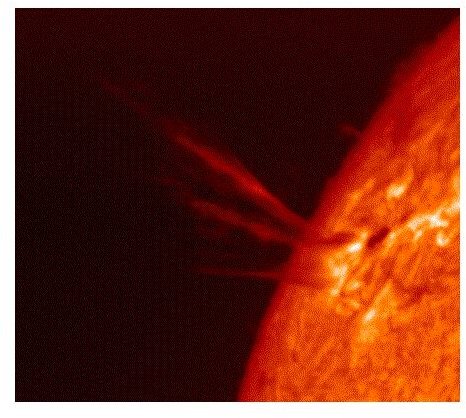What Is Thermal Energy and How Can It Be Measured?

Science has defined many different kinds of energy that can be used for different purposes. Humans and many other living things derive chemical energy from food. In physics, thermal energy is understood as a combination of kinetic and potential energy of an object in motion. In terms of this concept, motion includes the movement of atoms which may not be visible to the naked eye. However, the presence of thermal energy is often apparent - a block of solid butter that starts to melt contains both kinetic and potential energy. In some fields, the terms “thermal energy” and “heat” are used synonymously. For example, the Sun can be thought of as a source of thermal energy as well as light.
Besides the Sun, there are many different sources of thermal energy. Car engines, fires, electrical heaters, compost heaps, warm-blooded animals (including people), and friction (e.g. rubbing you hands together quickly generates thermal energy) are some of the most common examples. Not all sources of thermal energy are desirable or easy to manage. In some settings, such as your home on a winter day, thermal energy is something you need. In other cases, your computer can suffer if it does not properly handle heat.
The Importance of Thermal Energy In Technology and Engineering
Understanding what thermal energy is is important in many different fields in order to design systems, devices and environments that are safe and reliable. In the field of engineering, understanding thermal energy lets people appreciate how to move heat energy between systems. For example, engineers may need to design a steam turbine to generate electricity. In that case, the goal would be to convert thermal energy into electrical energy with as little loss as possible. In automotive design, thermal energy represents a challenge as well - the process of burning gasoline creates a great deal of energy that is not translated into vehicle motion or other useful functions. The design of air conditioning units involves harnessing thermal energy and transferring that energy (e.g. from a living room in a house to the outdoors) in order to produce a more comfortable environment.
The examples above are some of the obvious situations where managing thermal energy is vital. But did you know that thermal energy is an important issue in computers and electronics? Though electronics and computers are not designed to harness or control heat, they do create heat. Without compensating mechanisms, a modern computer would experience failures and cease to function if too much thermal energy built up. For this reason, most laptop and desktop computers make use of heat sinks, fans and other technologies to manage thermal energy. The problem of managing thermal energy is a frequent challenge that engineers and designers face.
How It Is Measured
Depending on the context, there are several ways to measure thermal energy. The two most common units of measurement for this type of energy are the Joule (J) and the calorie (cal). In modern science, the joule is the SI unit of measurement for energy of all kinds including chemical, thermal and electrical energy. Burning a standard barrel of oil (i.e. 42 U.S. gallons or 159 liters) generates approximately six gigajoules of chemical energy (i.e. six billion joules of energy). The energy content of food can also be expressed in joules, but another unit of measure - the calorie - is more commonly used in food. In most circumstances, thermal energy is measured using a thermometer denominated in Fahrenheit, Celsius and Kelvin. These units can be converted into Joules and calories if needed. Joules are the most commonly used unit of measure for energy, but it is not universally used: British Thermal Units (BTUs) and calories are commonly used in other situations.
As a non-SI unit of measurement, the calorie is not universally used in science but it is common in some contexts. In countries where the metric system is not widely used, such as the United States, the calorie is a common unit of measure. One tablespoon of white sugar contains about 15 kilocalories of energy while one ounce of cheddar cheese contains approximately 114 kilocalories of chemical energy. Though the energy value can be expressed in calories, this measurement alone does not completely describe the nutritional value of food.
In some situations, the British Thermal Unit (BTU) of measurement is used to describe how machines and systems manage heat. Equivalent to approximately 1055 Joules, BTUs are most commonly used in reference to heating and cooling machines (e.g. air conditioning units in homes). One BTU is required to increase the temperature of one pound of liquid water from 39 F to 40 F. Originally developed in the United Kingdom in 1956, BTUs are also used in the field of steam generation and by natural gas companies. Energy companies that produce oil, natural gas and coal products can describe their energy value of their products in terms of BTUs since these fuels commonly create energy through combustion which creates thermal energy.
Experiments You Can Do on Your Own
There are many types of thermal energy experiments you can conduct to learn more. These examples will get you started - you may also want to ask your chemistry or physics teachers for more ideas.
-
Thermal Energy For Work: How can thermal energy be used to perform work such as raising the temperature of a room or generating electricity? You can experiment by using three different amounts of heat on an object.
-
Insulation Experiment: Insulation can be used to retain heat or keep heat out. Experiment with several different materials (e.g. wood, rubber, and plastic) to compare how they absorb heat.
References
- U.S. Energy Information Administration, Thermal Energy
- Image Credit: Solar Corona, NASA/Wikimedia Commons
- Human Nutrition, Encyclopedia Britannica